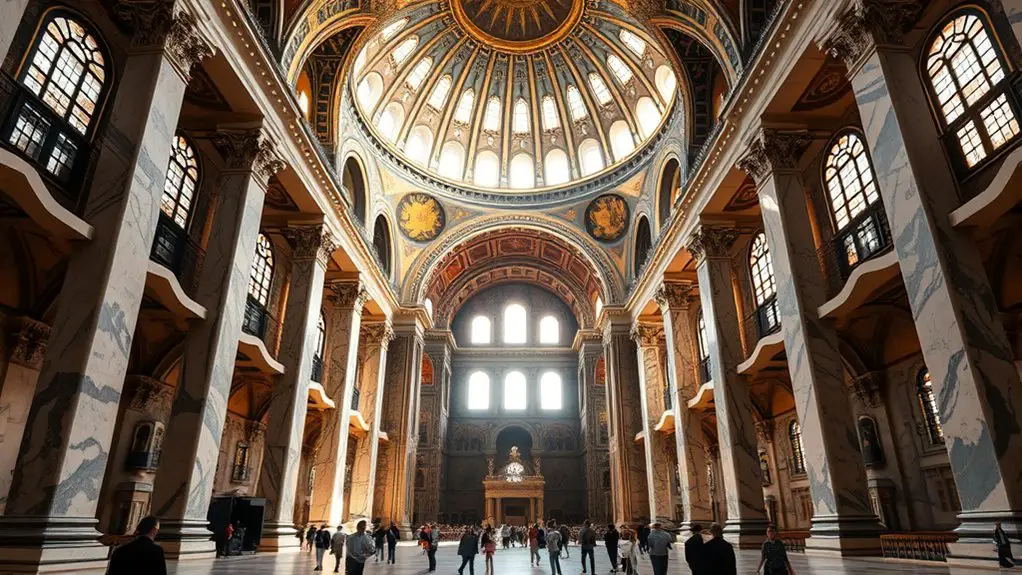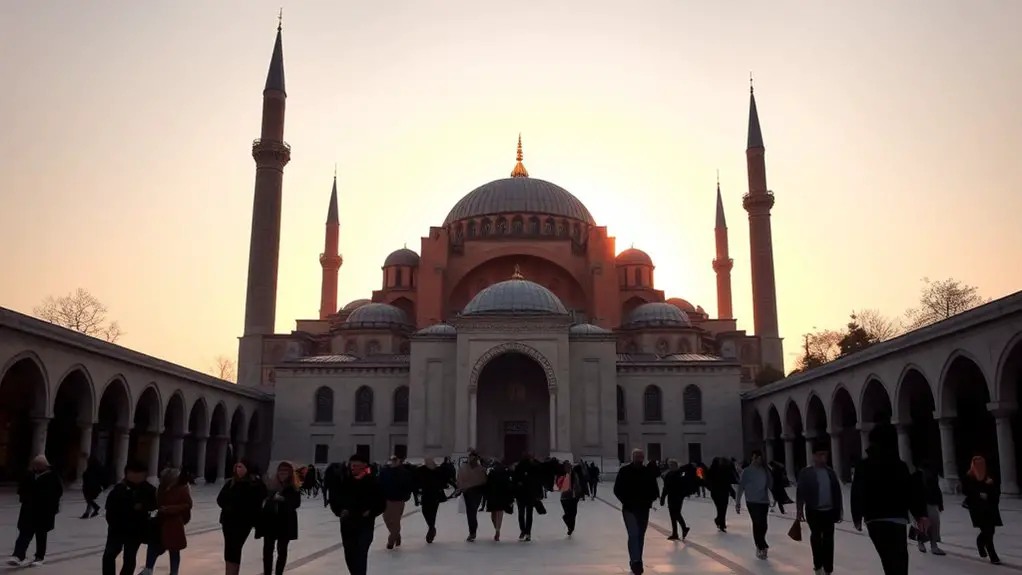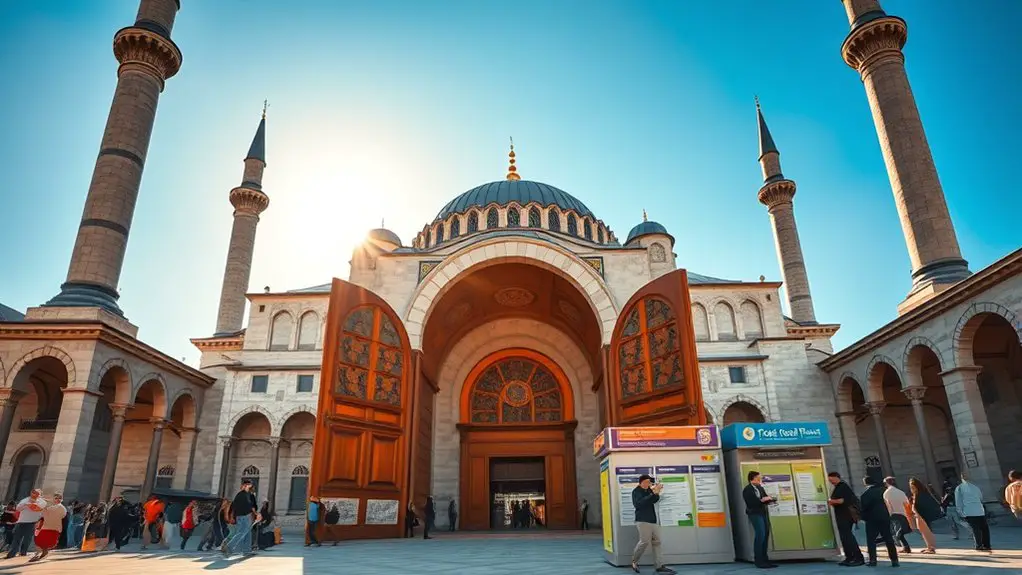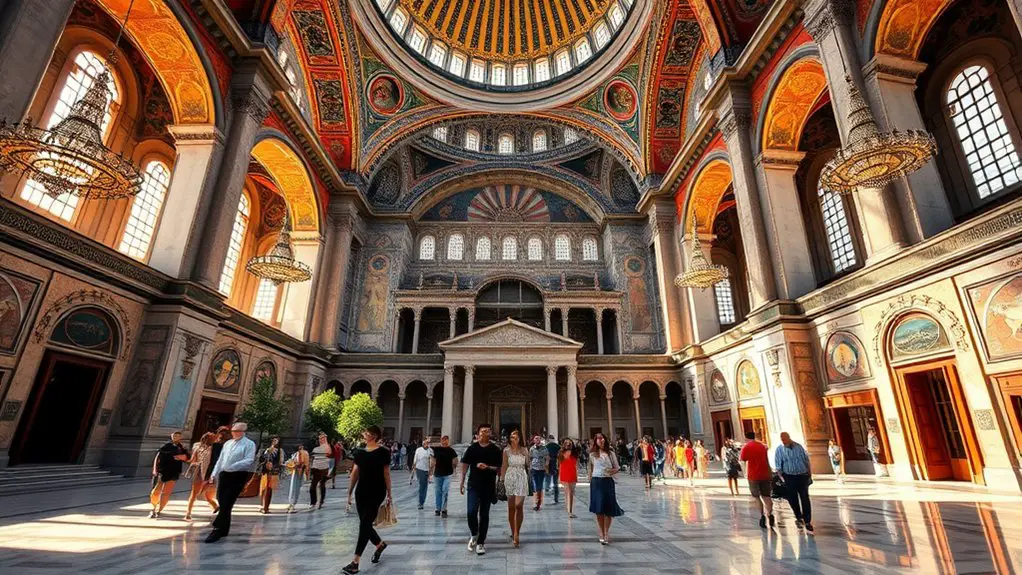When you plan your visit to Hagia Sophia, consider a few key tips to enhance your experience. Arriving early or late can help you avoid the crowds, allowing you to appreciate its grandeur in a more peaceful atmosphere. Dressing modestly shows respect for its religious significance. But there’s more to explore beyond just the main attraction. Let’s uncover the best ways to make the most of your time at this iconic site.
Key Takeaways
- Visit early morning or late afternoon on weekdays to avoid crowds and enjoy a more peaceful experience.
- Dress modestly to respect local customs, covering shoulders and knees; women may want to bring a scarf.
- Entry is currently free; check for guided tour options and any available discounts for students or groups.
- Admire the stunning mosaics and architectural details, and consider a guided tour for enriched historical insights.
- Practice photography etiquette by avoiding tripods, asking permission for photos of individuals, and respecting prayer zones.
Plan Your Visit Ahead of Time

When you plan your visit to the Hagia Sophia, it’s essential to take into account key factors that will enhance your experience.
Start by researching the stunning Hagia Sophia architecture, which beautifully marries Byzantine and Ottoman styles. This masterpiece, with its massive dome and intricate mosaics, stands as a reflection of centuries of artistic ingenuity.
Understanding its historical significance will deepen your appreciation. Once a cathedral, later a mosque, and now a museum, it reflects the diverse cultural history of Istanbul.
Don’t forget to check for any guided tours that explain the rich narratives behind the structure, making your visit more enriching.
Arriving prepared will allow you to soak in the breathtaking beauty and profound stories embedded in every corner of this iconic site.
Choose the Right Time to Go

To make the most of your visit to the Hagia Sophia, timing is essential. You’ll want to avoid the crowds to appreciate its stunning architecture and rich history fully. The best visiting hours are early in the morning or late in the afternoon. By choosing these times, you can wander through the vast halls with fewer distractions.
Timing is key to fully appreciating the Hagia Sophia’s stunning architecture—visit early or late for a serene experience.
Here are some tips to help you plan your visit:
- Visit on weekdays: This helps you dodge the weekend rush, as peak tourist times usually hit Saturday and Sunday.
- Check for holidays: Local holidays can draw larger crowds, so planning around them can enhance your experience.
- Arrive right at opening: Being among the first guests allows you to enjoy the beauty of the Hagia Sophia in relative peace.
With these tips, you’ll create lasting memories in this breathtaking landmark!
Understand the Entrance Fees and Tickets

After you’ve chosen the right time to visit, it’s important to understand the entrance fees and ticketing process for the Hagia Sophia. Currently, entry to this magnificent structure is free, but it’s wise to check for any upcoming changes or special exhibitions that may require a ticket.
There are various ticket types to evaluate if you’re planning guided tours, which can enhance your experience with deeper insights into its history and architecture.
If you’re a student or part of a group, don’t forget to ask about entrance discounts, as these can make your visit more budget-friendly.
Also, be aware of any specific days when discounted rates might apply. By staying informed about ticket types and available discounts, you can make the most of your visit to this historical gem.
Enjoy your journey through time at the Hagia Sophia!
Dress Appropriately for the Occasion
When visiting the Hagia Sophia, it’s essential to dress in a way that respects its rich religious traditions.
Comfortable footwear is a must, as you’ll want to explore every stunning detail without discomfort.
Additionally, make sure to check the weather and dress appropriately, so you can fully enjoy your experience inside this magnificent monument.
Respect Religious Traditions
As you prepare to visit the Hagia Sophia, it’s essential to reflect on the significance of dressing appropriately to show respect for its rich religious traditions.
By adhering to the local religious customs, you demonstrate cultural sensitivity and appreciation for this iconic site. Here are some tips to keep in mind:
- Cover your shoulders and knees: Opt for clothing that’s modest and respectful.
- Consider a scarf or shawl: This can be used to cover your head if you’re a woman, aligning with local customs.
- Avoid flashy attire: Choose simple, understated outfits to honor the sacred atmosphere.
Comfortable Footwear Recommended
While showing respect for the religious traditions at Hagia Sophia, it’s equally important to contemplate your comfort during the visit. You’ll likely spend several hours exploring this magnificent site, so wearing comfortable shoes is essential.
The vast halls and intricate details invite you to wander, but uneven floors and cobblestones can challenge your walking experience. Opt for supportive footwear that allows you to stroll freely without discomfort.
Sneakers or cushioned sandals work well, enabling you to absorb the awe of the stunning mosaics and soaring domes. Remember, a pleasant walking experience enhances your appreciation of this historical marvel, making your visit truly memorable.
Weather-Appropriate Attire Necessary
Dressing appropriately for the weather is essential to fully enjoy your visit to Hagia Sophia, especially since the climate can change throughout the day.
Depending on when you visit, consider the local climate and seasonal considerations to guarantee your comfort as you explore this magnificent site.
Here are a few tips to keep in mind:
- Layer Up: Mornings can be chilly, so wear layers that you can easily remove as the day warms up.
- Light Fabrics: In summer, opt for breathable materials to stay cool while wandering through the crowds.
- Rain Gear: If you’re visiting during the rainy season, a lightweight waterproof jacket or umbrella will save you from getting soaked.
Being prepared will enhance your experience at this historic landmark!
Explore the Rich History of Hagia Sophia
Hagia Sophia, a stunning architectural marvel, has stood for over 1,500 years, enchanting visitors with its rich and multifaceted history. Originally built as a cathedral in 537 AD, it showcases the brilliance of Byzantine architecture. As you walk through its grand halls, you’ll feel the weight of its historical significance, having served as a church, mosque, and now a museum.
| Period | Function | Key Features |
|---|---|---|
| 537 – 1453 | Cathedral | Dome, Mosaics |
| 1453 – 1931 | Mosque | Minarets, Calligraphy |
| 1935 – 2020 | Museum | Artifacts, Exhibits |
| 2020 – Present | Mosque | Open for worship |
You can’t help but be captivated by the stories embedded in its walls. Explore this magnificent structure and let its history inspire you.
Take Your Time to Admire the Mosaics
As you wander through the awe-inspiring halls of Hagia Sophia, don’t miss the chance to admire its breathtaking mosaics. These stunning works of art showcase the rich history and cultural fusion of the monument. Take your time, and immerse yourself in the intricate mosaic details that tell stories of faith and artistry.
- Look for the famous Deesis mosaic, featuring Christ flanked by the Virgin Mary and John the Baptist.
- Notice the vibrant colors and gold accents, which enhance the visual impact and depth.
- Don’t forget to appreciate the diverse styles, blending Byzantine and Islamic influences.
Engaging with these mosaics not only enriches your visit but also deepens your art appreciation. Each piece invites you to reflect on the craftsmanship and devotion that went into its creation.
Consider a Guided Tour
How can a guided tour enhance your experience at Hagia Sophia? Opting for a guided experience can transform your visit from a simple walkthrough to an immersive journey through history.
Knowledgeable guides bring the stunning architecture and rich history to life, sharing fascinating stories about the building’s transformation from a cathedral to a mosque and now a museum.
With their insights, you’ll discover hidden details in the mosaics and learn about the cultural significance behind each element.
You’ll also avoid the overwhelm of trying to navigate and interpret everything on your own, allowing you to appreciate the artistry and spirituality of the space even more.
Furthermore, guided tours often include access to areas that might be restricted or overlooked by casual visitors.
Be Mindful of Photography Etiquette
When you visit Hagia Sophia, it’s essential to respect its sacred atmosphere, especially if a religious service is taking place.
Remember, tripods aren’t allowed, so keep your photography discreet and unobtrusive.
Respect Religious Practices
While exploring the magnificent Hagia Sophia, you’ll want to be respectful of its religious significance, especially when it comes to photography.
This iconic site serves as a place of worship, and practicing cultural sensitivity is essential. Here are some photography etiquette tips to keep in mind:
- Observe designated areas: Stay clear of prayer zones and areas where worshippers gather.
- No flash photography: Respect the solemn atmosphere by avoiding the use of flash, which can be disruptive.
- Ask permission: If you want to take photos of individuals, always ask first to honor their religious customs.
No Tripods Allowed
As you navigate the awe-inspiring interiors of Hagia Sophia, remember that tripods aren’t allowed.
These tripod restrictions are in place to preserve the serenity of this historic site and guarantee everyone can enjoy its beauty.
While capturing the stunning mosaics and grand arches, keep in mind the photography rules that encourage respectful behavior.
Instead of a tripod, consider using your camera’s higher ISO settings for low-light conditions, or try stabilizing your shot against a wall or pillar.
This way, you can still create stunning photos without disrupting the flow of visitors.
Embrace the moment, and let your creativity shine while respecting the rules that protect this magnificent monument.
Enjoy the Surrounding Area and Other Attractions
Stepping outside the magnificent Hagia Sophia opens up a world of vibrant sights and sounds that beckon to be explored.
You’ll find iconic landmarks and experiences waiting just a stone’s throw away. Don’t miss the chance to immerse yourself in the local culture and indulge in some delicious local cuisine.
Here are a few attractions you shouldn’t overlook:
- Topkapi Palace: Just a short walk away, this stunning palace offers a glimpse into the opulent life of Ottoman sultans.
- Gülhane Park: Relax in this beautiful park, perfect for a leisurely stroll or picnicking amidst lush greenery.
- Sultanahmet Square: This bustling area is great for people-watching and soaking in the atmosphere, surrounded by historic architecture.
Take your time to explore the surroundings; it’s all part of the unforgettable experience of visiting Hagia Sophia!
Frequently Asked Questions
Are There Any Restrictions on Food and Drinks Inside Hagia Sophia?
Yes, there are restrictions on food and drinks inside Hagia Sophia.
You can’t bring your own snacks or beverages, as the site aims to preserve its sacred atmosphere.
While dining options nearby offer a chance to grab a bite, it’s best to enjoy your meal outside.
This policy helps maintain the site’s tranquility, ensuring you can fully appreciate the stunning architecture and rich history without distractions from food activities.
Is There Parking Available Near Hagia Sophia for Visitors?
Yes, there are parking options available near Hagia Sophia.
You’ll find several facilities that cater to visitors, making it convenient for you to explore the area. Some nearby parking lots offer reasonable rates, while street parking might be available, though it can be limited.
Make sure to check for any restrictions and fees. Arriving early could help you secure a spot, allowing you to soak in the beauty of this historic site without any stress.
Are Restrooms Available Inside the Hagia Sophia?
Yes, there are restroom facilities inside Hagia Sophia for visitors.
You’ll find them conveniently located, ensuring you don’t have to venture far during your exploration. The hygiene standards are generally well-maintained, providing a clean environment.
Just keep an eye out for signs directing you to the restrooms. With the crowds, it might be a good idea to plan your visits during less busy times, making your experience smoother and more enjoyable.
Can I Bring a Backpack or Large Bags Inside?
You can’t bring a backpack or large bags inside the Hagia Sophia due to the strict backpack policy.
However, there’s convenient luggage storage available nearby where you can safely leave your belongings. This way, you can explore the stunning architecture and rich history without any hassle.
Make sure to check the storage facility’s hours and fees before you go, so you’re fully prepared for your visit and can enjoy every moment!
Is Hagia Sophia Accessible for Visitors With Mobility Challenges?
Yes, Hagia Sophia is accessible for visitors with mobility challenges.
You’ll find wheelchair access at the entrance and throughout the main areas, making it easier to explore this magnificent site.
Consider joining a guided tour, as they often accommodate various needs, ensuring you don’t miss any highlights.
The stunning mosaics and architecture are worth experiencing up close, and the staff is typically friendly and ready to assist.
Enjoy your visit!
Conclusion
To sum up, your visit to Hagia Sophia can be a truly enriching experience if you plan ahead and embrace its beauty. Arriving early or late helps you avoid the crowds, while dressing modestly shows respect for its significance. Don’t rush; take your time to admire the stunning mosaics and consider a guided tour for deeper insights. Finally, explore the vibrant surrounding area and indulge in the local cuisine to make your trip unforgettable. Enjoy every moment!
